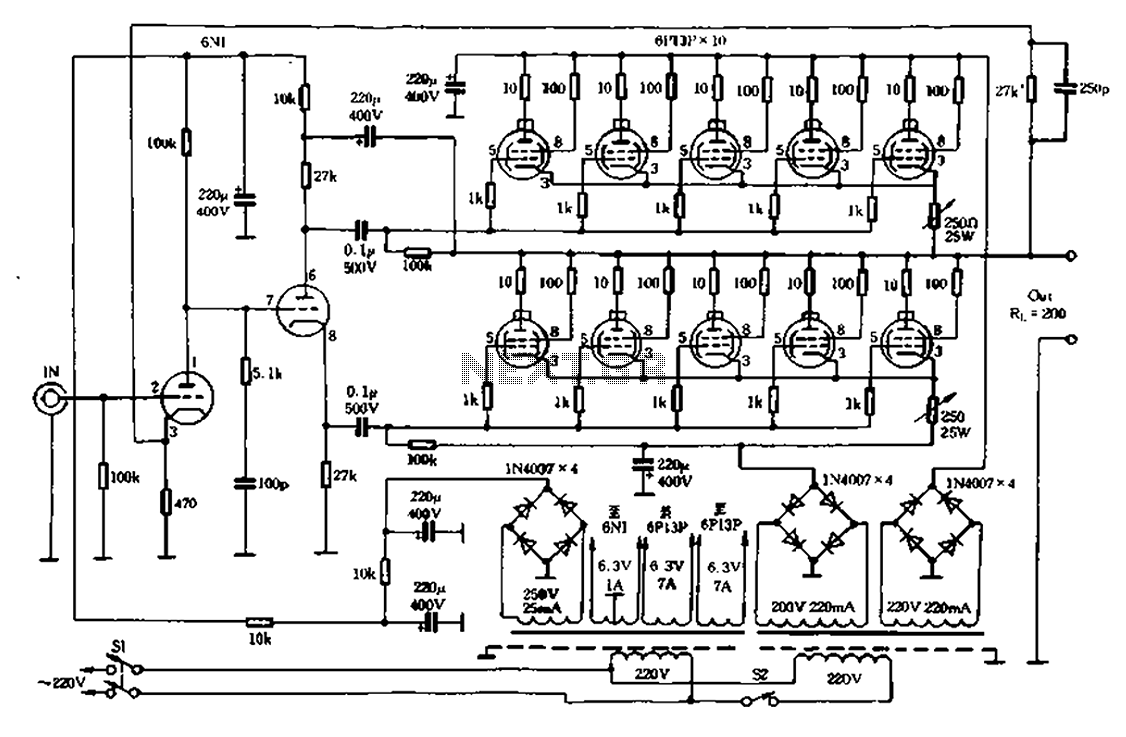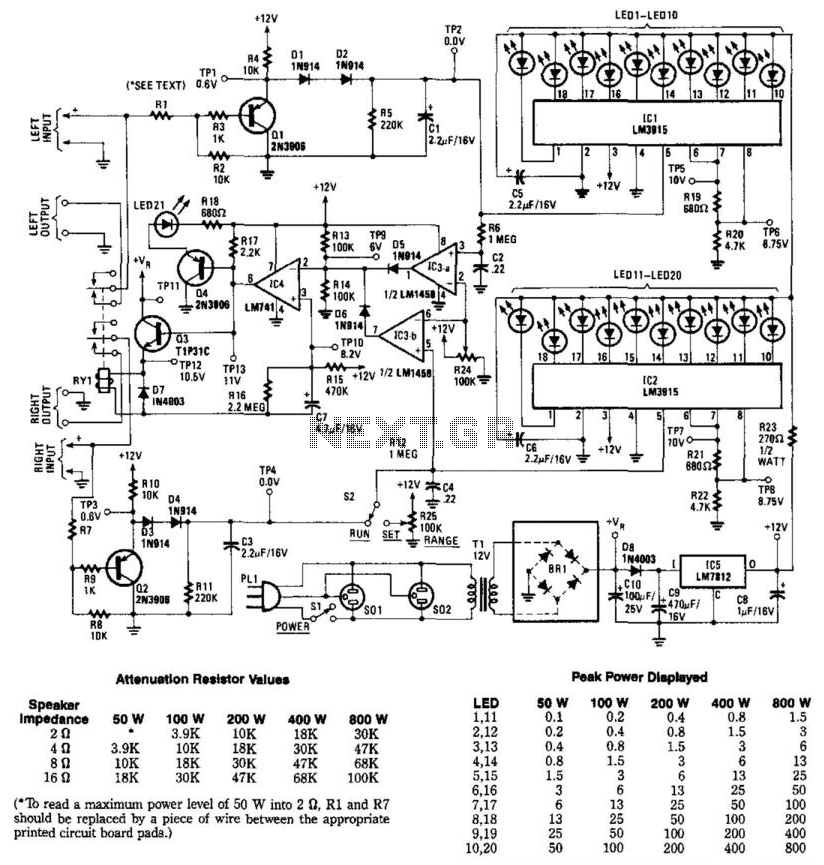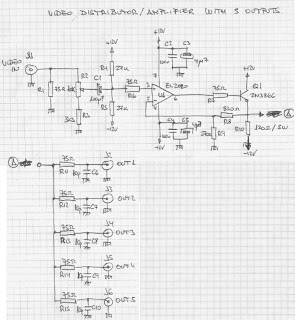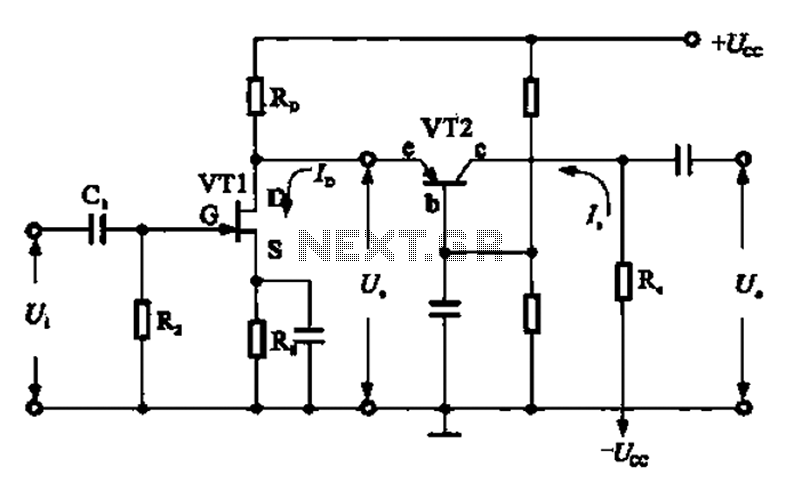
400 Watt 80 Meter RF Amplifier
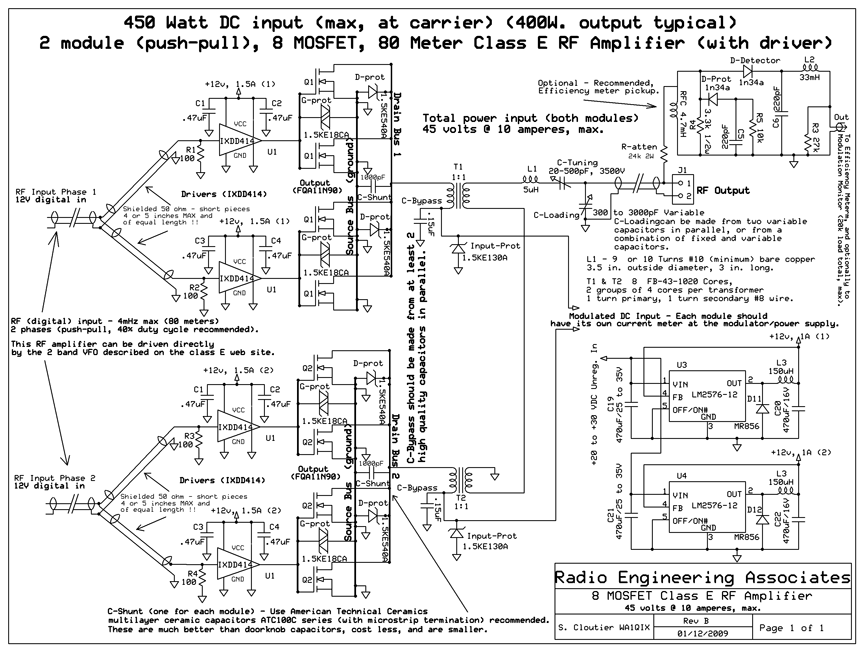
This Class E RF amplifier is capable of delivering up to 400 watts of RF output, depending on the input voltage and tuning parameters (current). The amplifier employs economical IXDD414 Driver ICs, with one driver for every two MOSFETs. To safeguard the MOSFETs from damage due to accidental overvoltage, Transient Voltage Suppressors (TVS devices) are utilized on the gates, drain bus, and modulated DC input to the RF amplifier. The carrier DC voltage must range between 40 volts and 50 volts, with a maximum of 135 volts at full positive peak modulation. The amplifier consists of eight MOSFETs arranged in two identical four MOSFET RF amplifier stages connected in a single-ended push-pull configuration. Each stage includes an RF driver (IXDD414 ICs), with one IC for every two MOSFETs. The driver IC inputs are interconnected to form a semi-bus, with a 100-ohm termination resistor connected to ground at each end of the driver bus, resulting in a 50-ohm termination. The drivers are connected to the VFO using 50-ohm coaxial cable. Each driver bus operates out of phase with the other, ensuring that when one is "on," the other is "off." The outputs are combined out of phase, maintaining the single-ended push-pull configuration. TVS (TransZorb) devices are employed on the drain and gate buses, as well as on the modulated DC input to each amplifier stage.
Construction notes indicate that the shunt capacitors (C-Shunt) in the schematic are ATC (American Technical Ceramics) ATC100C series capacitors, rated at 1000pF with a tolerance of 20%, utilizing MicroStrip (MS) termination. The MicroStrips are fabricated from solid silver, facilitating easy installation and soldering of the capacitors into the circuit. The 15uF RF bypass capacitors (C-Bypass) consist of two orange drop capacitors in parallel, with the option of using two or three capacitors combined to achieve the desired capacitance value. High current, low ESR (equivalent series resistance) capacitors of good quality are recommended. The exact value of the RF bypass capacitors is not critical, with a range between 12uF and 17uF being effective. When using a pulse width modulator, the RF bypass capacitor integrates into the last capacitor in the PWM filter, necessitating knowledge of its value during filter construction.
The transmitter utilizes IXDD414 driver ICs, with one for every two MOSFETs (on 75 meters). Each driver IC is equipped with its own RF bypass capacitor, connected from the VCC to the ground plane. The power requirement for the driver ICs on 75 meters (all four drivers) is approximately 2.5 amperes at 12VDC. An LM2576 pulse width modulator IC can supply up to 3 amperes of DC at 12V, which is adequate for the four IXDD414s on 75 meters. The output terminal of each driver IC is directly connected to the gates of two FQA11N90 output MOSFETs. In this configuration, the gate leads of the FQA11N90s are bent to facilitate a direct connection, with the output of the IXDD414 linked to the junction of the gate leads. Alternatively, a small bus can be employed for this connection. The ground terminals of each driver IC are directly connected to the source bus, and the tab (also ground for the driver ICs) is secured to the heat sink. It is crucial to keep all interconnecting leads as short as possible to minimize stray inductance, particularly for the driver RF bypass capacitor connections. The drivers receive input via 50-ohm coax cable (RG58 or similar), with each cable terminated by two 100-ohm resistors at each IXDD414 driver IC (two driver ICs per module), achieving a 50-ohm termination. The gate waveform generated by a single IXDD414 driver controlling two FQA11N90 MOSFETs exhibits high quality at 75 meters, approaching a true square wave at 160 meters, resulting in a stable and efficient Class E amplifier. This two-module Class E RF amplifier incorporates two RF output transformers, one for each module, constructed using eight FB-43-1020 (type 43) cores, organized in two groups of four.This Class E RF amplifier will deliver up to 400 watts of RF output, depending on the input voltage and tuning parameters (current). The amplifier uses inexpensive IXDD414 Driver ICs - one for every 2 MOSFETs. Transient Voltage Supressors (TVS devices) are used on the gates, drain bus and modulated DC input to the RF amplifier to protect the MOSFE
Ts from damage due to accidental overvoltage. The carrier DC voltage should be between 40 volts and 50 volts, and no more than 135 volts at full positive peak modulation. The 8 MOSFET RF amplifier consists of two identical 4 MOSFET RF amplifier stages connected together in a single ended push pull configuration.
Each amplifier stage (module) includes an RF driver (IXDD414 ICs), one IC for every 2 MOSFETs. The driver IC inputs are connected together to form a semi "bus", with a 100 ohm termination resistor connected to ground at each end of the driver bus, forming a 50 ohm termination. The drivers are connected to the VFO using 50 ohm coaxial cable. Each driver bus is driven out of phase with the other, so when one is "on" the other is "off". The outputs are also combined out of phase, giving the single ended, push pull configuration. TVS (TransZorb) devices are used on the drain and gate busses, and on the modulated DC input to each amplifier stage.
Construction Notes: The shunt capacitors C-Shunt in the schematic are ATC (American Technical Ceramics) ATC100C series capacitors, 1000pF, 20% with MicroStrip (MS) termination. The MicroStrips are made from solid silver, and make it very easy to install and solder the capacitors into the circuit.
The. 15uF RF bypass capacitors (C-Bypass) are made from 2 orange drop capacitors in parallel. 2 or 3 capacitors may be used in combination to obtain the desired capacitance value. The capacitors should by high current, low ESR (series reactance-resistance) good quality capacitors. Note: The exact value of the RF bypass capacitors is not critical. Anything between. 12 and. 17 uF will work very well. If you are using a pulse width modulator, the RF bypass capacitor becomes part of the last capacitor in the PWM filter, and the value of the bypass capacitor must be known when building the filter.
The transmitter uses IXDD414 driver ICs, one for every 2 MOSFETs (on 75 meters). Each driver IC has its own RF bypass capacitor, connected from the VCC to the ground plane. The power requirement for the driver ICs on 75 meters (all 4 drivers) is around 2. 5 amperes at 12VDC. An LM2576, pulse width modulator IC can deliver up to 3 amperes of DC at 12V - more than enough current for the 4 IXDD414s on 75 meters. The output terminal of each of the driver ICs is connected directly to the gates of 2 of the FQA11N90 output MOSFETs.
In this particular example, the gate leads of the FQA11N90s are bent in such a way as to faciliate a direct connection, and the output of the IXDD414 is connected to the junction of the gate leads. A small bus can also be used. The ground terminals of each driver ICs are connected directly to the source bus, and the tab (also ground for the driver ICs) is bolted directly to the heat sink.
All interconnecting leads should be kept as short as possible to minimize stray inductance, particularly the driver RF bypass capacitor connections. The input to the drivers is delivered via 50 ohm coax cable (RG58 or similar 50 ohm thin cable), and each cable is terminated by a 2 100 ohm resistors, one at each IXDD414 driver IC (2 driver ICs per module), forming a 50 ohm termination.
The gate waveform produced by a single IXDD414 driver driving 2 FQA11N90 MOSFETs is very good on 75 meters, and approaches a true square wave on 160 meters. This results in a very stable and efficient class E amplifier. This 2 module class E RF amplifier uses 2 RF output transformers, one for each module. The RF output transformers are each construted using 8 FB-43-1020 (type 43) cores, stacked in 2 groups of 4
🔗 External reference
Construction notes indicate that the shunt capacitors (C-Shunt) in the schematic are ATC (American Technical Ceramics) ATC100C series capacitors, rated at 1000pF with a tolerance of 20%, utilizing MicroStrip (MS) termination. The MicroStrips are fabricated from solid silver, facilitating easy installation and soldering of the capacitors into the circuit. The 15uF RF bypass capacitors (C-Bypass) consist of two orange drop capacitors in parallel, with the option of using two or three capacitors combined to achieve the desired capacitance value. High current, low ESR (equivalent series resistance) capacitors of good quality are recommended. The exact value of the RF bypass capacitors is not critical, with a range between 12uF and 17uF being effective. When using a pulse width modulator, the RF bypass capacitor integrates into the last capacitor in the PWM filter, necessitating knowledge of its value during filter construction.
The transmitter utilizes IXDD414 driver ICs, with one for every two MOSFETs (on 75 meters). Each driver IC is equipped with its own RF bypass capacitor, connected from the VCC to the ground plane. The power requirement for the driver ICs on 75 meters (all four drivers) is approximately 2.5 amperes at 12VDC. An LM2576 pulse width modulator IC can supply up to 3 amperes of DC at 12V, which is adequate for the four IXDD414s on 75 meters. The output terminal of each driver IC is directly connected to the gates of two FQA11N90 output MOSFETs. In this configuration, the gate leads of the FQA11N90s are bent to facilitate a direct connection, with the output of the IXDD414 linked to the junction of the gate leads. Alternatively, a small bus can be employed for this connection. The ground terminals of each driver IC are directly connected to the source bus, and the tab (also ground for the driver ICs) is secured to the heat sink. It is crucial to keep all interconnecting leads as short as possible to minimize stray inductance, particularly for the driver RF bypass capacitor connections. The drivers receive input via 50-ohm coax cable (RG58 or similar), with each cable terminated by two 100-ohm resistors at each IXDD414 driver IC (two driver ICs per module), achieving a 50-ohm termination. The gate waveform generated by a single IXDD414 driver controlling two FQA11N90 MOSFETs exhibits high quality at 75 meters, approaching a true square wave at 160 meters, resulting in a stable and efficient Class E amplifier. This two-module Class E RF amplifier incorporates two RF output transformers, one for each module, constructed using eight FB-43-1020 (type 43) cores, organized in two groups of four.This Class E RF amplifier will deliver up to 400 watts of RF output, depending on the input voltage and tuning parameters (current). The amplifier uses inexpensive IXDD414 Driver ICs - one for every 2 MOSFETs. Transient Voltage Supressors (TVS devices) are used on the gates, drain bus and modulated DC input to the RF amplifier to protect the MOSFE
Ts from damage due to accidental overvoltage. The carrier DC voltage should be between 40 volts and 50 volts, and no more than 135 volts at full positive peak modulation. The 8 MOSFET RF amplifier consists of two identical 4 MOSFET RF amplifier stages connected together in a single ended push pull configuration.
Each amplifier stage (module) includes an RF driver (IXDD414 ICs), one IC for every 2 MOSFETs. The driver IC inputs are connected together to form a semi "bus", with a 100 ohm termination resistor connected to ground at each end of the driver bus, forming a 50 ohm termination. The drivers are connected to the VFO using 50 ohm coaxial cable. Each driver bus is driven out of phase with the other, so when one is "on" the other is "off". The outputs are also combined out of phase, giving the single ended, push pull configuration. TVS (TransZorb) devices are used on the drain and gate busses, and on the modulated DC input to each amplifier stage.
Construction Notes: The shunt capacitors C-Shunt in the schematic are ATC (American Technical Ceramics) ATC100C series capacitors, 1000pF, 20% with MicroStrip (MS) termination. The MicroStrips are made from solid silver, and make it very easy to install and solder the capacitors into the circuit.
The. 15uF RF bypass capacitors (C-Bypass) are made from 2 orange drop capacitors in parallel. 2 or 3 capacitors may be used in combination to obtain the desired capacitance value. The capacitors should by high current, low ESR (series reactance-resistance) good quality capacitors. Note: The exact value of the RF bypass capacitors is not critical. Anything between. 12 and. 17 uF will work very well. If you are using a pulse width modulator, the RF bypass capacitor becomes part of the last capacitor in the PWM filter, and the value of the bypass capacitor must be known when building the filter.
The transmitter uses IXDD414 driver ICs, one for every 2 MOSFETs (on 75 meters). Each driver IC has its own RF bypass capacitor, connected from the VCC to the ground plane. The power requirement for the driver ICs on 75 meters (all 4 drivers) is around 2. 5 amperes at 12VDC. An LM2576, pulse width modulator IC can deliver up to 3 amperes of DC at 12V - more than enough current for the 4 IXDD414s on 75 meters. The output terminal of each of the driver ICs is connected directly to the gates of 2 of the FQA11N90 output MOSFETs.
In this particular example, the gate leads of the FQA11N90s are bent in such a way as to faciliate a direct connection, and the output of the IXDD414 is connected to the junction of the gate leads. A small bus can also be used. The ground terminals of each driver ICs are connected directly to the source bus, and the tab (also ground for the driver ICs) is bolted directly to the heat sink.
All interconnecting leads should be kept as short as possible to minimize stray inductance, particularly the driver RF bypass capacitor connections. The input to the drivers is delivered via 50 ohm coax cable (RG58 or similar 50 ohm thin cable), and each cable is terminated by a 2 100 ohm resistors, one at each IXDD414 driver IC (2 driver ICs per module), forming a 50 ohm termination.
The gate waveform produced by a single IXDD414 driver driving 2 FQA11N90 MOSFETs is very good on 75 meters, and approaches a true square wave on 160 meters. This results in a very stable and efficient class E amplifier. This 2 module class E RF amplifier uses 2 RF output transformers, one for each module. The RF output transformers are each construted using 8 FB-43-1020 (type 43) cores, stacked in 2 groups of 4
🔗 External reference
Warning: include(partials/cookie-banner.php): Failed to open stream: Permission denied in /var/www/html/nextgr/view-circuit.php on line 713
Warning: include(): Failed opening 'partials/cookie-banner.php' for inclusion (include_path='.:/usr/share/php') in /var/www/html/nextgr/view-circuit.php on line 713
